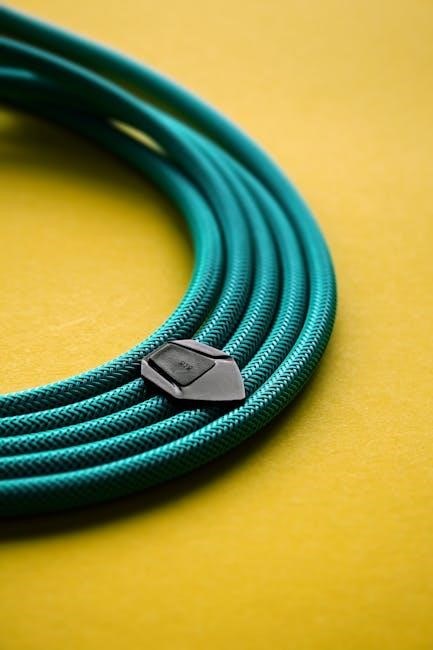The electrical cable gland size chart pdf provides a comprehensive guide for selecting the right gland size, ensuring safe and reliable connections, with detailed tables and diagrams for easy reference and use.
Cable Gland Selection Process
The cable gland selection process involves several factors, including cable type, size, and material, as well as the environment in which the gland will be used.
A cable gland selection chart is typically used to determine the correct gland size for a given cable, taking into account the cable’s diameter, number of cores, and insulation type.
The chart provides a range of gland sizes and corresponding cable diameters, allowing users to select the most suitable gland for their application.
It is essential to follow the selection process carefully to ensure a safe and reliable connection.
The electrical cable gland size chart pdf is a valuable resource for this process, offering a comprehensive guide to selecting the right gland size.
By using the chart and following the selection process, users can ensure that their electrical connections are safe, reliable, and meet the required standards.
The selection process is critical to preventing damage to equipment and ensuring the safety of people and property.

Understanding Cable Gland Size Recommendations
Size recommendations are based on cable diameter, cores, and insulation type, ensuring safe connections, with charts and guides available for reference and use always.
Cable Construction Details and Size Selection
Cable construction details play a crucial role in size selection, with factors such as conductor material, insulation type, and armor thickness affecting the overall diameter. The electrical cable gland size chart pdf provides a comprehensive guide to cable construction, including details on conductor sizes, insulation materials, and armor types; By understanding these construction details, users can select the correct gland size for their cable, ensuring a safe and reliable connection. The chart includes tables and diagrams to help users navigate the complex process of cable selection, with information on cable diameter, cores, and insulation type. With this information, users can make informed decisions about gland size selection, reducing the risk of errors and ensuring compliance with industry standards. The cable construction details and size selection guide is an essential resource for anyone working with electrical cables.

Importance of Material and Finishes in Cable Glands
Materials like brass and stainless steel are used, with finishes affecting corrosion resistance and durability, ensuring safe connections always.
Sealing Ring and Thread Specifications
The sealing ring and thread specifications are crucial components of the cable gland, ensuring a secure and reliable connection. The sealing ring is typically made of neoprene rubber, providing a tight seal to prevent moisture and dirt from entering the gland. The thread specifications are also important, with different types of threads available, such as metric or PG threads. The thread size and type will depend on the specific application and the type of cable being used. It is essential to select the correct thread specification to ensure a secure connection and to prevent damage to the gland or cable. The sealing ring and thread specifications are provided in the cable gland size chart pdf, making it easier to select the correct components for your specific application. This information is vital to ensure safe and reliable connections. Proper installation is also necessary.

Cable Gland Size Chart for Industrial and Hazardous Areas
Charts provide gland sizes for industrial and hazardous areas, following IEC 60079 standards, ensuring safe connections, with specific tables and guides for various cable types and applications always.
Size Selection Chart for Armoured Cable with Steel Wire Armouring
The size selection chart for armoured cable with steel wire armouring provides a detailed guide for choosing the correct gland size, considering factors such as cable diameter, conductor cross-sectional area, and number of cores.
The chart lists the minimum and maximum cable diameters suitable for different gland sizes, labelled as Groups A and B, depending on the number of cable cores and cable diameter, to ensure a secure and reliable connection.
This information is crucial for industrial and hazardous area applications, where safety and compliance with standards such as IEC 60079 are paramount.
The chart is based on cables manufactured to BS 5467, but it is recommended to measure the cable to select the most accurate gland size.
Using the correct gland size is essential to prevent damage to the cable and ensure the integrity of the connection, and the size selection chart provides a valuable resource for this purpose, making it easier to select the right gland size for armoured cables with steel wire armouring.
Guidelines for Gland Size Selection Based on Cable Diameter
Guidelines provide cable diameter measurements to select correct gland sizes accurately.
Minimum and Maximum Cable Diameters for Different Gland Sizes
The electrical cable gland size chart pdf includes tables that outline the minimum and maximum cable diameters for different gland sizes, helping users to select the correct gland size for their specific cable requirements.
These tables are organized by gland size and type, making it easy to find the relevant information.
The tables also provide information on the number of cable cores and the cable diameter range for each gland size, ensuring that users can make an informed decision when selecting a gland size.
Additionally, the tables are based on cables manufactured to BS 5467, providing a standard reference point for users.
By using these tables, users can ensure that they select a gland size that is compatible with their cable, reducing the risk of errors and ensuring a safe and reliable connection.
The tables are easy to read and understand, making it simple for users to find the information they need to select the correct gland size.
Overall, the tables provide a valuable resource for users, helping them to select the correct gland size for their specific needs.

Downloading the Electrical Cable Gland Size Chart PDF
Download the free pdf guide for easy reference and use always online.
Benefits of Using the Free PDF Guide for Gland Size Selection
The free PDF guide for gland size selection offers numerous benefits, including easy access to detailed tables and diagrams, helping users to quickly determine the correct gland size for their specific cable type and application.
The guide is available for download at any time, making it a convenient resource for engineers, electricians, and other professionals working with electrical cables.
By using the free PDF guide, users can ensure that they are selecting the correct gland size, which is essential for maintaining the safety and integrity of electrical connections.
The guide is particularly useful for those working in industrial and hazardous areas, where the correct selection of gland size is critical for preventing accidents and ensuring compliance with relevant standards and regulations.
Overall, the free PDF guide is a valuable resource for anyone involved in the selection and installation of electrical cable glands.
on Electrical Cable Gland Size Chart
The chart provides a comprehensive guide for selecting the correct gland size, taking into account various factors such as cable type, size, and application.
By using the chart, users can avoid common mistakes that can lead to accidents and equipment damage.
The availability of the chart in PDF format makes it easily accessible and convenient to use.
Overall, the electrical cable gland size chart is an essential resource for professionals working with electrical cables, and its use can help to prevent accidents and ensure compliance with relevant standards and regulations.
The chart is a valuable asset for anyone involved in the installation and maintenance of electrical systems, and its importance should not be overlooked.
Proper use of the chart can help to ensure the safety and reliability of electrical connections.



Leave a Reply
You must be logged in to post a comment.